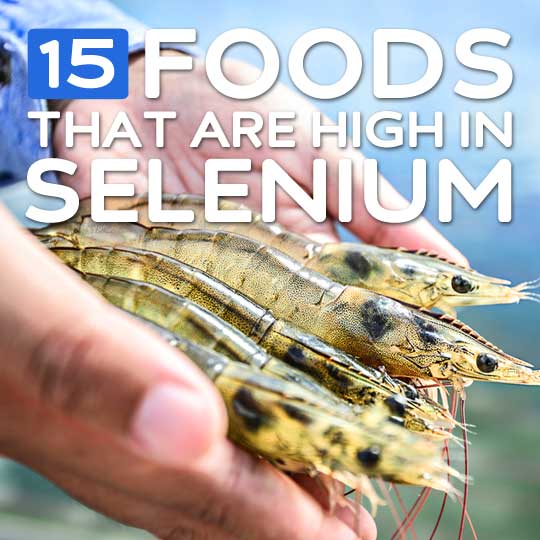Getting enough selenium in your diet is important for your overall health and wellbeing. It helps keep your thyroid functioning properly, and the thyroid in turn helps pretty much every cell you have. The good news is that it’s not very hard to keep your selenium levels topped up, as long as you’re not a vegetarian and eat a balanced diet. The list of foods below all rank relatively high in selenium, so you can eat more if you’re trying to boost your levels, or avoid them if you’re trying to get them down.
[hr]

1. Tuna
Tuna contains a decent amount of selenium, as well as protein and omega-3s, all of which play a part in a healthy and balanced diet. You’re advised to only eat tuna a few times a week due to mercury concerns, but most health experts agree it’s worth including in your diet for all of the benefits it provides. Albacore is a great choice in tuna and is available at most grocery stores. Serving Size (100 grams), Selenium (80.4 mcg), 115% DV
[hr]
2. Sunflower Seeds
Sunflower seeds are also relatively high in selenium, and also have healthy fats that your body needs to be at its best. So even though it’s relatively high in fat, it’s coming from polyunsaturated and monounsaturated fat, which are the healthy kinds of fat. Opt for dry roasted for a tasty treat. Serving Size (100 grams), Selenium (53 mcg), 76% DV
[AdSense-A]
3. Pork
Pork may not be the healthiest meat to eat, but it does rank among the foods highest in selenium. Billed as “the other white meat” for decades, most pork products are not a high quality protein, and carry with them a larger amount of fat than chicken breast or lean beef. But it can be included in a healthy diet, especially one that is focused on getting enough selenium on a daily basis. Serving Size (100 grams), Selenium (35.4 mcg), 51% DV
4. Octopus and Squid
Here are two often overlooked sources of protein that are big in other parts of the world, but haven’t caught on in the states. If fried calamari is the closest you’ve ventured into eating these two sources of food, it’s time to give them another try. Keep in mind that fresh octopus and squid that is cooked properly should not be chewy, a common complaint from those that try it improperly cooked or not fresh enough. Serving Size (100 grams), Selenium (89.6 mcg), 128% DV
[hr]

5. Chicken
Because of the widespread availability of chicken it’s one of the easiest foods to start getting more of if it’s not already part of your regular diet. Opt for organic chicken breasts to get a high quality source of protein without all of the antibiotics and growth hormones pumped into conventional chickens. It’s low in calories, low in fat if you go with skinless, and 27% of chicken breast is pure protein. Serving Size (100 grams), Selenium (27.6 mcg), 39% DV
[hr]
6. Eggs
The egg campaign tried to get us to believe that eggs are incredible and edible, and when it comes to selenium, they pretty much are. Depending on how you cook them, there will be more or less selenium. The numbers listed here are in reference to a hard-boiled serving of two eggs at 50 grams each. These numbers put eggs on many lists of foods containing a good dose of selenium, and they are also a good source of protein and omega-3 if you buy eggs that are fortified with it. Serving Size (100 grams), Selenium (31.7 mcg), 45% DV
7. Salmon
Salmon ranks as a superfood thanks to its high protein count, high levels of omega-3s, and impressive levels of healthy fats. Many health experts recommend eating salmon several times per week as part of a diet to keep cancer and heart disease away. It also has a respectable amount of selenium per serving, while keeping calories in check. The great thing is that a few of the other foods listed on this page pair well with salmon, like mushrooms and lentils so you can get a double dose. Serving Size (100 grams), Selenium (46.8 mcg), 67% DV
[hr]
8. Mushrooms
Pick your favorite mushrooms and chances are they’ll be a good source of selenium. This is great because mushrooms are used in plenty of recipes, and can combine with other vegetables to make a nice side dish to a wide assortment of entrees. It’s easy enough to start getting more mushrooms in your diet, you just have to pick your favorite kind. Serving Size (100 grams), Selenium (9.3 mcg), 13% DV
[hr]

9. Cheese
This is happy news to those that enjoy their cheese and want another reason to eat it. Cheese gets a lot of flack for being high in fat, calories, and sodium, but some try to defend it because of its calcium and protein content. If you’re looking to increase your selenium and you don’t eat meat, but you’re OK with consuming dairy products, this might be one avenue to meet your selenium requirements. Serving Size (100 grams), Selenium (13.9 mcg), 20% DV
[hr]
10. Oysters
They say oysters are an aphrodisiac, and they also contain a good dose of selenium, which helps regulate the thyroid, which helps regulate sexual function, so there may be something to that. The vitamin B-12 is through the roof when it comes to oysters, and that also plays a part. They also provide a good amount of protein making them a suitable part of a healthy diet. Serving Size (100 grams, steamed), Selenium (63.7 mcg), 91% DV
11. Oats
Oats are often suggested as a way to help with heart health due to their cholesterol lowering effect. Here they’re ranking pretty good among foods highest in selenium. This is a good way to start your morning, making sure you have enough fuel to get you through to lunch, while getting part of your daily fiber needs met. Serving Size (100 grams), Selenium (28.9 mcg), 41% DV
12. Bacon
Bacon is often listed as an unhealthy food because it contains more than a full day’s worth of saturated fat, and a third of your cholesterol allowance in a 100 gram serving. At the same time it provides you with selenium, but this isn’t enough to justify an extra helping of bacon just to boost your selenium count. You have to look at the bigger picture and choose other foods on this list that are better for you overall. Serving Size (100 grams), Selenium (62 mcg), 82% DV
[hr]

13. Shrimp
Shrimp is a great protein choice when looking to up your selenium reserves. That’s because when you compare it to chicken and beef it has more selenium and fewer calories than either one. This doesn’t give a license for the endless shrimp special at your local seafood chain, but it does mean that you can enjoy shrimp in your regular menu lineup for it’s quality protein content and other benefits. Serving Size (100 grams), Selenium (39.6 mcg), 57% DV
[hr]
14. Beef
Beef is a source of selenium that is readily accessible and one of the most consumed meats in America, behind chicken. This is one reason why meat eaters don’t usually have a problem with low selenium, because the three top meats all contain it. Compared to the same 100 grams of chicken, beef actually contains less selenium, but contains more calories, which may be one reason beef ranks second, and sometimes third behind pork. Serving Size (100 grams), Selenium (21.6 mcg), 31% DV
15. Brazil Nuts
These rank highest in selenium content per 100 grams, and the count is so high that it’s virtually off the chart. Keep in mind that it is possible to get too much selenium in a day, so if you’ve had a serving of Brazil nuts you may want to take it easy on other foods that are high in it. Also consider that it may be easier to eat 100 grams of salmon than 100 grams of Brazil nuts, so it’s all relative. Serving Size (100 grams), Selenium (1,917 mcg), 2739% DV
[hr]
Selenium is an important mineral that you don’t want to run low on, but you have to make good eating choices and make sure that you’re getting a varied diet filled with plenty of healthy proteins, vegetables, and fruits, as well as healthy fats. You want to make sure you’re topped up in all of the most important vitamins and minerals, and this is the best way to do it. If you’re unable to eat these sort of foods daily, consider a selenium supplement but only after talking to your doctor to discuss your specific needs.




